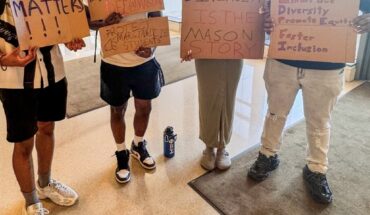The “Gender Inclusive Restrooms” project from the LGBTQ+ Resources Center to increase the inclusivity and accessibility of restrooms on Mason’s Fairfax Campus.
BY VALENTINA FALA, STAFF WRITER
A “Gender Inclusive Restrooms” project has been ongoing at Mason for more than 10 years. The project, which started in the spring of 2011, began when the LGBTQ Campus Climate Task Force was created by University Life to investigate the situation of LGBTQ+ students on campus including but not limited to infrastructure needs. It was paused since COVID-19 first hit, but recently the project has become a topic of interest for Mason Student Government.
According to the LGBTQ Campus Climate Task Force Report in 2012, the purpose of the task force’s creation was “to discover how free [the LGBTQ+ community] felt to be themselves on this campus and what Mason’s programs and departments might do to promote a campus community that is fully welcoming, safe, respectful and inclusive for students, faculty, and staff of all sexual orientations, gender identities and expressions.”
Junior Bas Rawat, Speaker Pro Tempore and Former Chair of the Diversity & Multicultural Affairs committee, was one of the people interested in revisiting the initiative that involves gender-neutral bathrooms.
“A gender-neutral bathroom is typically a single-stalled restroom that anyone can use. It is also meant to be accessible, as well as a family restroom,” Rawat said. “A lot of trans people/gender non-conforming students/faculty feel uncomfortable using gendered restrooms on campus.”
Josh Kinchen, the Director of the LGBTQ+ Resources Center, makes a clear difference between single and multi-stall restrooms. “The only slight and basic difference between a single stall restroom and a gender inclusive restroom is that we have an approved sign and ADA compliant sign.” Kinchen said.
According to Kinchen, the project includes restrooms with a new toilet symbol rather than two gender-conformed people, braille included. Additionally, there is an interactive Gender Inclusive Restrooms map, uploaded by the LGBTQ+ Resources Center, that shows up-to-date restrooms with these new signs.
Kinchen explains gender neutral restrooms would help transgender and non-binary students in feeling more comfortable and safe on campus. “Folks who don’t look the way that folks think that they should look have been accosted and assaulted in restrooms… we want to create space for everybody to be able to get all their needs met and just use the bathroom at peace.”
Additionally, Kinchen suggests that an increase of single-stall restrooms will improve Mason’s accessibility for those with disabilities. “Folks that have certain medical needs that they need specific privacy for [and] multi-stall restrooms aren’t really going to work for them.”
The initiative has had obstacles with pacing and funding. Kinchen explains that the campus is lacking in the amount of single-stall restrooms on campus, while some buildings do not have them at all. “There’s a major issue of cost… how do we find millions of dollars of funding to install, convert, [and] do all the things we need to do to make that a reality?” Kinchen said.
“The initiative’s goal is to create more inclusion on campus. Kinchen said, “It’s critical for folks to be able to use the facilities, use the restroom, be able to have space that is comfortable. Safe and private… we’re behind the baseline in terms of having those restrooms everywhere that we need them on campus.”



